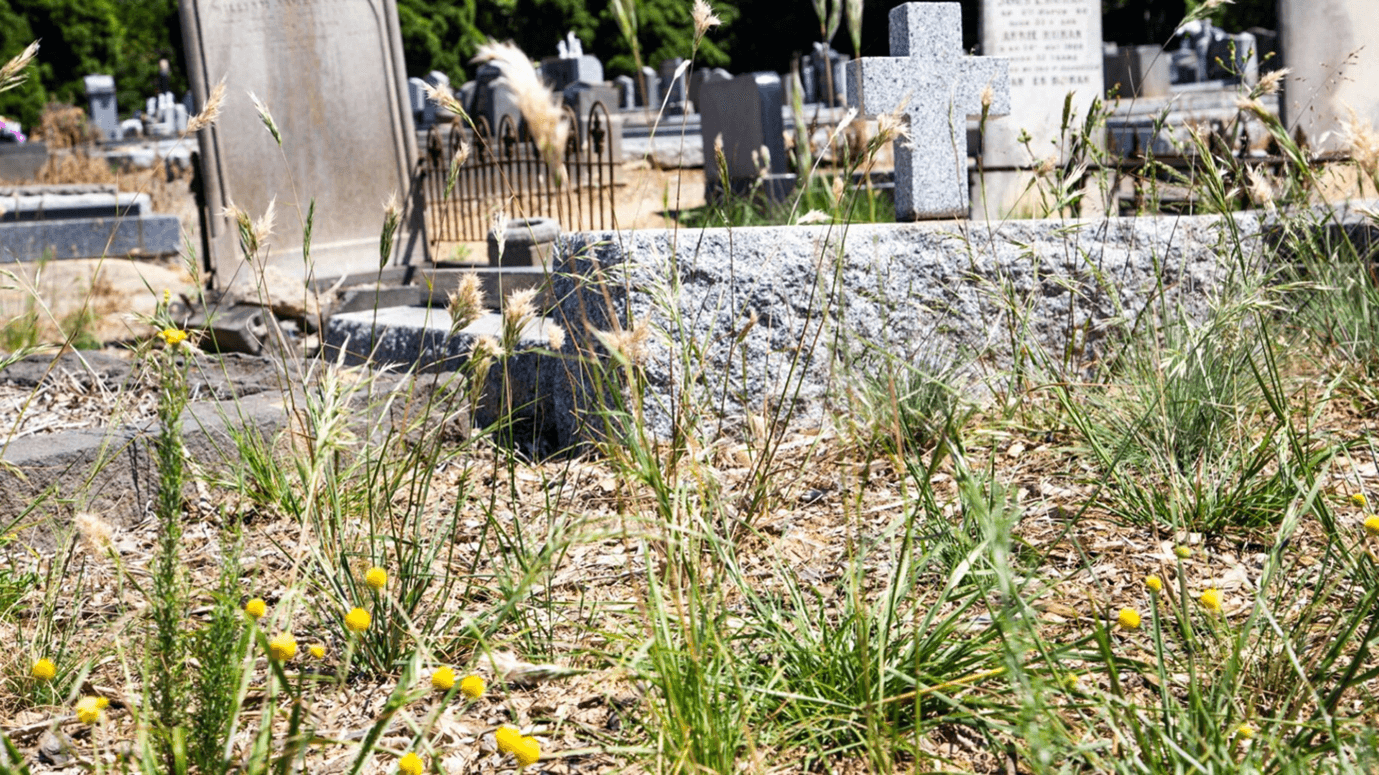Meet the plants of Project Cultivate
- 11 January 2024

Project Cultivate
Since March 2023, the Project Cultivate team has been working to convert significant areas of barren, compacted clay soil across Melbourne General Cemetery (MGC) into a flourishing green space by laying mulch and planting more than 120,000 indigenous plants.
With the first phase of the pilot now complete, we’re starting to see these efforts come into full fruition following ideal springtime conditions in Melbourne. We thought this would be a great opportunity to introduce you to some of the 19 locally native plant species visitors can now find at MGC.

Billy Buttons
The iconic, eye-catching, indigenous Golden Billy Buttons (Pycnosorus chrysanthes) can now be found throughout the Project Cultivate areas in MGC. You’ll also find the native Drumstick Billy Buttons (Pycnosorus globosus) in our gardening group's trial area. Immediately recognisable for its bright yellow globe-like flowers, these attractive perennial plants are like sunshine on a stem, bringing joy to passers-by as they bloom throughout spring and summer.
Native bees, butterflies and moths also love the nectar. Billy buttons prefer heavy, moist soils and a position in full sun (which is why they do so well in our challenging clay soils at MGC). Great in pots or planted en-masse, Billy Buttons are great in native, courtyard, coastal and cottage gardens, and are easy to propagate from seed collected in summer.

Clustered and Common Everlastings
Common Everlasting (Chrysocephalum apiculatum) and Clustered Everlasting (Chrysocephalum semipapposum) are both outstanding indigenous ground covers perfect for MGC. With soft, silvery leaves, these plants look great all year round but put on an especially stunning show from spring till the end of autumn when dense clusters of bright yellow flowerheads appear on the ends of stems.
These hardy plants are tolerant of a range of soils and conditions while providing food for native caterpillars and nectar for butterflies and native bees. An impressive spread of up to 1m per plant allows for a dense ground cover that suppresses weeds while adding gorgeous greenery to the Project Cultivate grasslands area.

Kangaroo Grass
Before the MGC site was used as a cemetery, the area was likely a grassy woodland dominated by river red gums and diverse indigenous grasses, herbs, forbs and wildflowers, with Kangaroo Grass (Themeda triandra) making up most of the understory. A stunning, clumping, perennial grass, Kangaroo Grass has been heavily planted throughout the Project Cultivate areas. The green to grey foliage dries into a rusty orange during summer, a sight that is manifestly Australian.
From late spring to autumn, brilliant bronze florets and seed heads appear on the ends of stems, adding texture, colour and interest. Kangaroo Grass provides an important habitat for beneficial insects, butterflies, reptiles, frogs, small birds and even mammals, getting its name due to being a preferred food source for, you guessed it, kangaroos. Indigenous Australians also used the foliage to make strings and nets, while seeds were ground, mixed with water and cooked to make a damper.

Native Flax
Delicate, delightful and definitely a favourite with the Project Cultivate team is the Native Flax (Linum marginale). This pretty perennial puts on a show over spring and summer, when small, sky-blue flowers appear en-masse, followed by smooth seed pods.
After flowering, the plant often dies back to the rootstock and reshoots with the return of regular rain. As a perennial, this plant can become dormant until conditions are suitable for new growth. Tolerant of frost, dry spells, heavy soils and full sun to part shade, Native Flax is tougher than it looks, and perfect for MGC.
Providing habitat for a range of beneficial insects, Native Flax is a subtle addition to cottage gardens, rockeries and wildflower meadows, and was highly valued by Indigenous people, who used the strong, fibrous stems to make twine and cord for fishing nets.

Wallaby Grasses
Five of the 19 indigenous plant species found across the Project Cultivate areas at MGC are Wallaby Grasses (Rytidosperma sp.) which would have once populated the area. These native grasses produce flowering spikelets from late spring through summer, making for an attractive feature when the sun and breeze create a shimmering effect.
Wallaby grasses are ideal for Project Cultivate, as they work well for revegetating disturbed soils, tolerating poor and shallow soils and minimising erosion. They also offer an important habitat for many native butterfly and moth species, including the vulnerable Golden Sun Moth, which almost certainly would have called this site home before it was a cemetery.
Discover Project Cultivate
Project Cultivate aims to improve visitor experiences while enhancing the natural environment of our historical cemetery sites. The project also strives to drive meaningful conversations about sustainability and revegetation, hoping to create a shared vision for the horticultural future of Victorian cemeteries. Learn more about the project hereExternal site.
Recommended articles

127,000 native plants to be sown at Melbourne General Cemetery
- 9 October 2024
As part of the Southern Metropolitan Cemeteries Trust’s (SMCT) horticultural pilot Project Cultivate, Melbourne General Cemetery is being revegetated with 127,000 native grasses, wildflowers and groundcovers, to create a flourishing grassland in the heart of the city.
- Project

Project Cultivate: Behind the Scenes
- 2 January 2023
We sat down with Horticulture Assets Manager Helen Tuton, who works closely on the pilot project at Melbourne General Cemetery, to talk all things Project Cultivate.
- Project

Community Comes Together for “Grassroots” Planting Day at Melbourne General Cemetery
- 23 October 2024
This special event, part of Project Cultivate, saw community members of all ages getting a hands-on experience, enhancing the biodiversity of our historic cemetery in the heart of Melbourne.
- Project